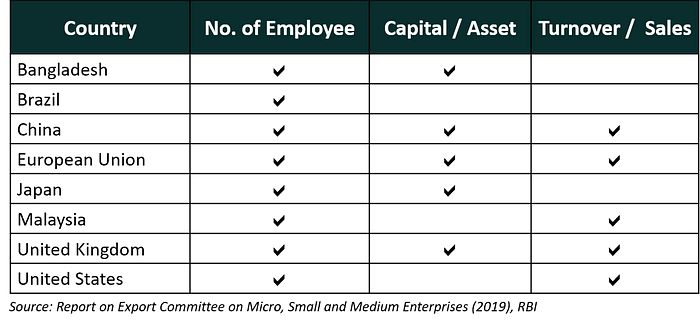The Re-Beginnan | Vol.2 | Issue 2
MSME sector accounted for nearly 33.4% of the total manufacturing output and 49% of total exports in 2017–18. Between 2015 and 2017, the contribution of the sector in GDP has been around 30%. Due to the national lockdown induced by COVID-19, businesses including MSMEs have been badly hit. To provide immediate relief to the MSME sector, the government announced several measures in May 2020. Following the announcement relating to the measures, definition of the MSMEs also underwent changes during the lockdown period. As per the latest definition, a company with up to INR 50 crore investments and up to INR 250 crore turnover is classified as a medium enterprise. Earlier, Finance Minister Mrs. Nirmala Sitharaman had announced investment limit for medium companies up to INR 20 crore and turnover up to INR 100 crore.
Ranking criteria for classification in MSMEs:
In 2014, the International Finance Corporation had analysed 267 definitions used by different institutions in 155 countries. According to the study, 92% of the definitions included employee strength in the classifying MSMEs, followed by turnover (49%) and value of assets (36%). Also, around 105 definitions were based only on the criteria of employee strength. The combination of assets and turnover was one of the lowest used criteria.
Following are the criteria used by selected countries to define MSMEs:

However, in the post Covid-19 period, Indian MSMEs will be identified basis the quantum of investment and annual turnover. Employee strength has not been included as a classification criterion despite it being used by other labour-intensive countries including China.
Why not employee strength?
In 294th Report on Micro Small and Medium Enterprises Development (Amendment) Bill 2018, the Standing Committee had recommended the inclusion of ‘no. of persons employed’ as criteria to define MSME. This recommendation was based on the fact that India is a labour-intensive country and the belief in the MSME sector for being most suitable platform to employment generation.
However, the recommendation was disregarded by the Expert Committee (RBI) and the Ministry of MSME. The criteria is seen to be adding to the challenges faced in the monitoring implementation of the definition. According to the Ministry of MSME, employment as a criterion has problems due to:
- factors such as seasonality and informal nature of engagement,
- similar to investment criteria, this would also require physical verification and has associated cost overheads.
Implication of changes in definition:
The change in the definition of MSMEs may result in many enterprises which are currently classified as Small enterprises be reclassified as Micro, and those classified as Medium enterprises be reclassified as Small. Further, there may be many enterprises which are not currently classified as MSMEs, which may fall under the MSME classification as per the new definition.
Such enterprises will also now benefit from the schemes related to MSMEs. The Ministry of MSME runs various schemes to provide for:
- Flow of credit to MSMEs,
- Support for technology upgrade and modernisation,
- Entrepreneurship and skill development, and
- Cluster-wise measures to promote capacity-building and empowerment of MSME units.
The above changes in the norms of classification are certainly expected to improve the ease of doing business for MSMEs and bring in transparency. It will also pave the way for increased direct and indirect employment in the MSME sector of the country.



